 Image search results - "stone" Image search results - "stone" |

Bridge to castle grounds. 5-min. walk from Fukui Station.
|
|

Ninomaru Northern Stone wall along a moat. 二の丸北面石垣
|
|

Bridge to castle grounds with prefectural capital building looming ahead.
|
|
|

Dobashi-mon Gate stone walls 土橋門石垣
|
|

Statue of castle founder and 1st lord, Yuki Hideyasu 結城秀康
|
|

Dobashi-mon Gate stone wall 土橋門石垣
|
|

Valley between the prefectural capital (left) and police department (right).
|
|

Dobashi-mon Gate stone wall. Notice the hexagonal stones. 土橋門石垣
|
|

Stone foundation of the castle tower at one corner.
|
|

Gate to Former Brigade Office 切手門
|
|

Stairs to castle tower foundation
|
|

Atop the castle tower foundation (lower level)
|
|

Sukiyashiki stone wall. Some markings are engraved on the stones. 数寄屋敷石垣
|
|

Monuments
|
|

Gokuraku-bashi Bridge 極楽橋
|
|

The castle tower suffered a major fire in 1669, and it was never rebuilt.
|
|

Stone walls seen from Gokuraku-bashi Bridge.
|
|

Steps to upper level of castle tower foundation
|
|
|

Top of castle tower foundation. Grassy, but uneven ground.
|
|

Kurogane (Tetsu)-mon Gate stone walls. Entrance to Honmaru. 鉄門石垣
|
|

Another stone foundation which was partially damaged during the 1948 Fukui Easrthquake.
|
|

Kurogane-mon Gate stone wall 鉄門石垣
|
|
|
|

Kurogane-mon Gate stone wall 鉄門石垣
|
|

Steps to go down.
|
|

Site of Inui Yagura Turret 戊亥櫓跡
|
|

View of moat from the corner of castle tower foundation.
|
|

Stones and Oku-no-miya Shrine
|
|

View from Inui Yagura Turret
|
|
|

Stone wall submerged in moat.
|
|

View from Inui Yagura Turret. Hashizumemon Gate on lower right.
|
|
|
|

Main entrance to Aoyama Cemetery during cherry blossom season in early April. Gaienmae Station (Ginza/Hanzomon Line) and Nogizaka Station (Chiyoda Line) are the closest subway stations.
|
|
|

Castle tower foundation
|
|

Hashizumemon-tsuzuki Yagura Turret
|
|

Aoyama Cemetery office near the main entrance where you can obtain a map of the cemetery and ask where particular people are buried. The maps they provide do not show where the most famous people are (such as prime ministers).
|
|
|

Main thoroughfare, lined with cherry trees, cuts through the middle of the cemetery where cars whiz by. Quite irritating.
|
|

View from Inui Yagura Turret
|
|

This is the castle well named Fuku-no-I (福の井). Fukui Prefecture got its name from this well. In 2017, it got a Japanese-style roof.
|
|

Cherry blossom tunnel at Aoyama Cemetery.
|
|

Inui Yagura Turret stone wall as seen from Hashizumemon-tsuzuki Yagura Turret.
|
|
|
|
|

Aoyama Cemetery is one of Tokyo's noted spots for cherry blossoms. However, having hanami picnics is not allowed.
|
|

Cherry blossoms are so fleeting. They last for only a short time, like life itself. And so cherry blossoms are often found at cemetaries in Japan.
|
|
|

These trees stood out.
|
|
|
|

Cherry blossoms and graves.
|
|

Stepping stones, called Isowatari, are another major feature of the garden.
|
|

Aoyama Cemetery map. Quite complicated system to find grave plots.
|
|
|

Yukimi Stone Lantern
|
|

Stepping stones, called Isowatari. 磯渡り
|
|

Signs tell you where you are. Quite bewildering mapping system.
|
|
|

Isowatari. 磯渡り
|
|

Site of Ushitora Yagura Turret. 丑寅櫓跡
|
|
|

Aoyama Cemetery has over 123,000 graves occupying 125,000 square meters within the cemetery land area of 263,564 sq. meters.
|
|
|

Place to rub the sacred balls. 珍宝窟
|
|

View from Ushitora Yagura Turret. Across the highway is Kenrokuen Garden.
|
|
|

Isowatari. 磯渡り
|
|

This is the Foreigner's Cemetery where many foreigners who helped to modernize Japan are buried.
|
|

Another bridge 廊下橋
|
|
|

A monument erected in March 2007 by Tokyo Governor Ishihara Shintaro in appreciation of the foreigners who helped build Japan.
|
|

Fukui police HQ and castle wall
|
|
|

List of foreigners buried in this Foreigner's Cemetery. Note that there also other foreigners buried in other parts of Aoyama Cemetery.
|
|
|

Rub the two balls.
|
|

Hishi Yagura Turret
|
|

Foreigner's Cemetery 外国人墓地
|
|
|

Put in money and it will make a "chin" sound. (From the word "chinpo" for penis.)
|
|

Foreigner's Cemetery 外国人墓地
|
|

Pedestrian bridge
|
|

Phallic fence posts.
|
|

Grave of Edoardo Chiossone (1833-1898), an Italian who introduced printing technology (for money and stamps) to Japan. He loved Japan and amassed a huge collection of Japanese art, especially woodblock prints. The collection is donated to a Genova museum.
|
|
|
|
|

Gravestone of Edoardo Chiossone
|
|
|

Phallic rock. There are several phallic rocks donated by various people. Apparently they are either natural or carved.
|
|

Higashi-no-Maru stone wall built using the oldest technique. 東の丸北面石垣Stone wall supporting the Ushitora Yagura Turret.
|
|

Grave of Joseph Heco who was born Japanese (as Hamada Hikozo) but naturalized as a US citizen.
|
|

Prefectural capital building
|
|

Best-looking phallic rock.
|
|

Grave of Joseph Heco
|
|

Mismatched buildings
|
|
|

Grave of the family of Robert Walker Irwin (1844-1925), Hawaiian Minister to Japan. (Iron gate has since been removed.)
|
|
|
|
|

Female and male rocks.
|
|

Graves of the family of Robert Walker Irwin (1844-1925), Hawaiian Minister to Japan.
|
|

Grave of Robert Walker Irwin (1844-1925), Hawaiian Minister to Japan and his Japanese wife Iki. Eldest child Bella Irwin is also buried here.
|
|

Gravestone of Robert Walker Irwin (1844-1925), Hawaiian Minister to Japan and his Japanese wife Iki.
|
|

Grave of Robert Walker Irwin Jr. (Robert Walker Irwin's first son) and his first wife Fusako.
|
|

Grave of Richard Irwin (Robert Walker Irwin's second son) and his son Takeo and daughter Yukiko Irwin.
|
|

Grave of Mary Irwin (Robert Walker Irwin's second daughter).
|
|

Grave of Tsuneko Irwin second wife of Robert Walker Irwin Jr. and her son John.
|
|

Grave of Tsuneko Irwin second wife of Robert Walker Irwin Jr. and her son John.
|
|

This stone monument gives the biography of Robert Walker. His birthdate, descendant of Benjamin Franklin, his move to Japan, companies he worked for in Japan including Mitsui Bussan, supervision of the immigration to Hawaii,founding of the Taiwan Sugar Co., and the decorations he received from the Japanese government. Died in 1925 at age 81.
ロベルト・ウォルカー・アルウインは米国費府
の住民にして西暦千八百四十四年一月七日
に生まれベンジャミン・フランクリンの後裔也
慶應二年十一月来朝し海外貿易又は日本海
運の開発誘導に貢献するところ頗る多く三
井物産会社其他に勤務し後ち日本駐劄布哇
国公使に就任して日本移民の布哇渡航を企
画成功す蓋し之れ日本移民海外発展の基と
なれるものにして実に日本移民事業の開祖
たり明治三十三年台湾製糖株式会社の創立
発起人となり日本糖業の為めに尽くすとこ
ろ又尠なからす勲一等に叙せられ瑞鳳章を
賜ひ後ち又旭日大綬章を賜ふ大正十四年一
月五日永眠す行年八十一才也
|
|

Monument dedicated to Bella, built by the Irwin Gakuen (formerly Gyokusei Gakuen) alumni association (Gyokusei-kai) for the school's 70th anniversary in Nov. 1985.The bottom has a bio of Bella.
|
|

This originally was for grave visitors to leave their business cards, but it does not work. (As of this writing, there is no receptacle to collect the cards.)
|
|

Graves of Robert Walker Irwin (rear, on the right) and his family. (Old photos of the graves.)
|
|
|

Behind the rocks are two trees bonded together.
|
|
|
|

Hashizumemon-tsuzuki Yagura Turret
|
|

Grave of loyal dog Hachiko and his master, Professor Ueno.
|
|

Grave of Yoshida Shigeru, Japan's first postwar prime minister.
|
|

Grave of Yoshida Shigeru 吉田茂の墓
|
|

Worst-looking phallic rock. That's stretching the imagination a little too much.
|
|

An unkept grave.
|
|

Famous stone
|
|

Ritto History Museum, stone buddha replica. 栗東歴史民俗博物館
|
|

Stone buddha
|
|

Folding screen (byobu) rock 屏風岩
|
|
|
|
|
|
|

Stone lantern
|
|
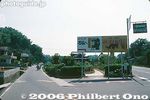
Way to the stone buddhas in Usuki.
|
|
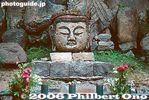
Buddha head before reattachement in 1994. 古園石仏
|
|
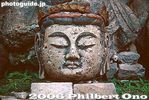
Closeup of Buddha head before reattachment in 1994. Usuki, Oita. 古園石仏
|
|
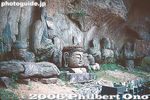
Stone buddhas in Usuki, Oita. 古園石仏
|
|

古園石仏
|
|

Stone buddhas, Usuki, Oita.
|
|
|
|
|
|

Stone buddha enclosed by a building. 山王山石仏
|
|
|

The outside wall also uses stones from the Sotobori Moat of Edo Castle.
|
|

Large stone walls
|
|

Chain railing
|
|

Chain railing really helps.
|
|

Way to cemetery. Six Hikone Castle lords, including Ii Naosuke, have graves here. Setagaya was the domain of the Ii clan who often worked in the Tokugawa government.
|
|

Straight ahead is the grave of Lord Ii Naotaka, the 2nd lord of Hikone Castle in Shiga Prefecture.
|
|

Turn left and you see this. Ii clan graves on both sides. Lord Ii Naosuke's grave is at the very end on the left.
|
|

Lord Ii Naosuke's grave is at the very end on the left.
|
|

Grave of Lord Ii Naosuke (1815-1860), the lord of Hikone Castle in Shiga Prefecture and Chief Minister of the Tokugawa Shogun's government. Gotokuji temple, Setagaya-ku, Tokyo. 井伊直弼の墓 豪徳寺
|
|

Only Ii Naosuke's grave has a sign explaining about him.
|
|

Grave of Lord Ii Naosuke (1815-1860), the lord of Hikone Castle in Shiga Prefecture and Chief Minister of the Tokugawa Shogun's government. Gotokuji temple, Setagaya-ku, Tokyo. 井伊直弼の墓 豪徳寺
|
|

Gravestone of Ii Naosuke.
|
|

Right side of Lord Ii Naosuke's grave.
|
|

Tree of white camellias grow about Lord Ii Naosuke's grave.
|
|

Grave of Lord Ii Naosuke's wife.
|
|
|

Grave of Lord Ii Naohide (1755-1789). He served as Tairo Chief Minister in the Tokugawa government. Gotokuji temple, Setagaya, Tokyo 井伊直幸
|
|

Grave of Lord Ii Naotaka's eldest daughter who donated a lot to the temple. 井伊直孝長女
|
|
|

Grave of Lord Ii Naotaka (1590-1659), 2nd lord of Hikone, Shiga. Gotokuji temple, Setagaya, Tokyo 井伊直孝
|
|

Grave of Lord Ii Naoyoshi (1727-1754), Gotokuji temple, Setagaya, Tokyo 井伊直禔
|
|

Grave of Lord Ii Naotsune (1693-1710), Gotokuji temple, Setagaya, Tokyo 井伊直恒
|
|

Grave of Lord Ii Naonori on right.
|
|

Grave of Lord Ii Naonori (1848-1904), Gotokuji temple, Setagaya, Tokyo 井伊直憲の墓
|
|

Six Jizo
|
|

It certainly gives you a different perspective of the castle as you see the moat, castle tower, and bridges from the water. The ride costs 1,200 yen.
|
|

Heading toward Otemon Gate/Bridge
|
|
|

Otemon Bridge
|
|

Going under Otemon Bridge. Wooden boards protect the bridge posts from the boat.
|
|

The boat is powered by very silent, battery-powered outboard motors.
|
|

Otemon Bridge
|
|
|

A few of the stones in the wall are black. Some say those stones might have come from Azuchi Castle after it was burned to the ground.
|
|

The next Otemon Bridge
|
|
|
|
|
|

Castle tower as seen from the moat
|
|

Castle tower
|
|

The boat includes a narrator who explains about the castle and moat and swans.
|
|
|
|

End of the moat. The moat once was connected to Lake Biwa, but not anymore since the lake's water level does not match the moat's water level.
|
|

End of the moat. Lake Biwa is right beyond. This is where we make a U-turn.
|
|
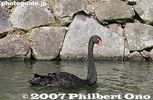
Black swan in Hikone Castle's moat, a gift from Mito in Ibraraki Prefecture.
|
|

Ready to pass under Otemon Bridge again.
|
|
|

Boat landing is near the entrance to Genkyu-en Garden.
|
|
|

End of the 50-min. ride. It was pleasant, and highly recommended. Boat landing for the Hikone-jo Ohori Meguri boat ride is near the entrance to Genkyu-en Garden.
|
|
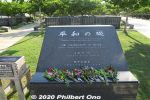
Cornerstone of Peace (平和の礎) in Mabuni, a large oceanfront memorial park full of these stone slabs inscribed with over 240,000 names of people who died in the battle.
|
|
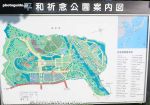
Map of Cornerstone of Peace witin the Okinawa Peace Prayer Park.
|
|
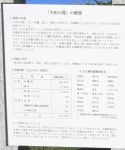
About the Cornerstone of Peace. http://www.peace-museum.pref.okinawa.jp/
|
|
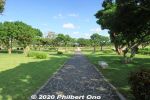
Walking to the Cornerstone of Peace.
|
|
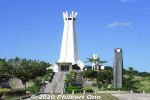
Peace Prayer Memorial Hall in the Okinawa Prefectural Peace Park.
|
|
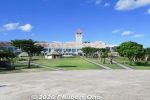
Okinawa Prefectural Peace Memorial Museum (沖縄県平和祈念資料館)
|
|
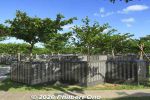
Stone slabs inscribed with over 240,000 names of people who died in the battle. Civilians and military, Japanese and foreign.
|
|
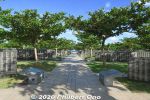
Japanese victims are inscribed by prefecture. Foreign nationals are inscribed by country.
|
|

Stone slabs are like folding screens in a slight zig-zag pattern.
|
|
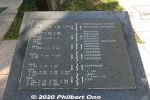
Map of where people's names are inscribed. Okinawans are inscribed according to their hometowns. Nearby are also war memorials for each prefecture.
|
|
|
|
|
|
|
|

Flame of Peace at the center of the Peace Plaza on the oceanfront. 平和の火
|
|
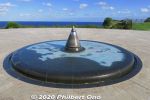
Flame of Peace in the world map. 平和の火
|
|
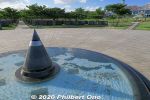
Flame of Peace in the world map. Japan can be seen in the map. 平和の火
|
|
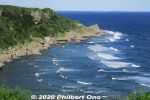
Mabuni Cliff
|
|
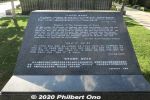
About the Cornerstone of Peace.
|
|
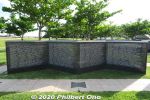
Names of 14,000+ Americans who died in Okinawa.
|
|
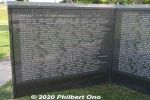
Names of 14,000+ Americans who died in Okinawa.
|
|
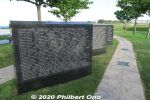
Slabs for 14,000+ Americans who died in Okinawa.
|
|
|
|
|
|
|
|
|
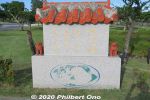
"Life is a Treasure..."
|
|
|
|
|
|

Graves of the Tadotsu Clan (多度津藩), a branch of the Kyogoku who ruled in Marugame. From left to right, Kyogoku Takateru (高琢), Takakata (高賢), Takabumi (高文), Takayoshi (高慶), and Takamichi (高通).
|
|

Kannon statues
|
|

Close-up of Kannon statue
|
|
|
|
|
|
|
|
|
|

Kannon at the top of the slope.
|
|
|
|
|
|

Bottom of slope
|
|

Adjacent to Tokugen-in temple is Kiyotaki Jinja Shrine with stone lanterns.
|
|
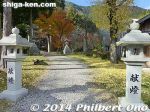
Kiyotaki Jinja Shrine
|
|
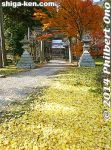
Gingko leaves
|
|
|
|
|
|

Bridge to Kiyotaki Jinja Shrine
|
|
|

Kiyotaki Jinja Shrine 清滝神社
|
|
|
|